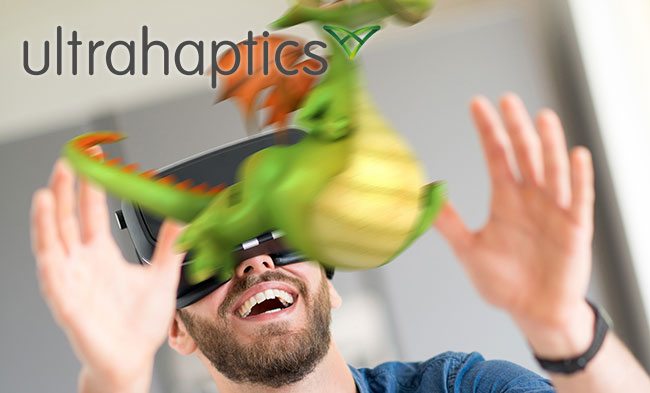Ultrahaptics allows users to touch virtual objects in the air with their fingertips using ultrasound technology. This technology then gets projected onto your hand as feedback sensations and lets you touch and move virtual objects in real time and use simple hand gestures to control interfaces.
The Gear

Before listing the gear, it’s important to note that Ultrahaptics gear is still in its development phase (devs and businesses check it out here) and isn’t available for consumer use just yet. The haptics kit consists of a 14×14 transducer array board, tracking sensors for hand gestures and movement (see Leap Motion), software and a development kit for building and programming sensations.
Magical Energy
This revolutionary mid-air touch tech was used during the week of Halloween at Hollywood’s famous Magic Castle. Participants experienced Ultrahaptics tech as they played an interactive gaming experience called INVASION!. Players set out on a mission to save the planet from space invaders and gather radioactive energy balls. The illusion of the energy ball’s physical presence was felt by placing hands inside the box where the participants could look on as the energy ball moved and shifted its weight a la haptics magic!
Producer, Programmer and Technical Director of Alien Invasion at The Magic Castle and Head of Education and VR/AR Association, Harry Evry, explained how Ultrahaptics tech flipped magic on its head and pushed it into a new era. He stated, “As magicians, producers and imagineers we are always looking for new tools and devices to help realize new illusions, fantasies and dreams. Ultrahaptics is an exciting new tool in our arsenal. With its flexible haptic projection arrays, we can truly paint and animate the sensation of touch, much as we control and manipulate light and sound.”
Touchless Gaming
Ultrahaptics has also partnered with the H2020 Levitate Project, with interns from four universities spearheading the creation of a haptic driven rhythm VR game. The interns had a field day with the Ultrahaptics Software Development Kit and created a playable game prototype that didn’t need tracked controllers or wearable techs like gloves or a suit. Instead, they used ultrasound waves to propel the shape and texture of balls/notes coming towards the player on a track like Guitar Hero or Soundboxing. Players could use their hands to move the balls with precision and each programmed sensation could be felt on the skin.
In a joint statement explaining their groundbreaking gaming development, Bao ZiaoTong, Shing Hei Chan, Boyin Yang, and Ziyuan Chen said, “We felt that haptics could give useful in-game feedback in a very intuitive way, so we decided to use different sensations to indicate hitting and missing. If there was no haptic feedback, players wouldn’t really know if they made the correct gestures or if they hit the note.”
Try to do that with standard VR controllers! The only indicator of successful or missed punching or impact in VR are visual cues and sounds. If Ultrahaptics is implemented in VR gaming, then home, gym and arcade use will likely see a rise in interest and acceptance of VR as a truly hands-free and immersive experience.
The Force
Star Wars is a fandom where The Force rules all — even in VR haptics. At a New Scientist Live event, participants that tested the Star Wars Ultrahaptics experience stuck their hand out in mid-air and felt The Force radiating from a lightsaber for the first time. Ultrahaptics took an ultrasonic speaker that radiated its waves towards hands, replicating painless vibrational “sparks” or what it would feel like to touch a lightsaber in all its greatness or evil. Let’s see this happen in a VR game backed by major studios and watch everyone come running to buy it.
VR Fitness Potential
The future value of Ultrahaptics in fitness and physical therapy is huge. Game development studios can use this technology to create action and movement games that don’t involve controllers or sweaty gloves. In physical therapy, the weightless haptic gesture and control system can help individuals who can’t hold heavy objects or who don’t have a full range of motion stay active and have fun doing it.
Are you as pumped up for Ultrahaptics technology as we are? Let us know which VR games you’d like to see get the mid-air haptic treatment in the comments section below!


